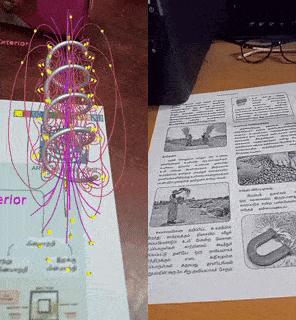Augmented Reality–Enhanced Textbooks
Scalable augmented reality pipeline embedding AR markers in textbooks, delivering interactive 3D learning via affordable smartphones for low-income schools; TNSCST-funded.
Published in 2023 4th International Conference on Electronics and Sustainable Communication Systems (ICESC) link🔗
What is this project about?
This project proposes a scalable augmented reality (AR) pipeline that integrates interactive 3D experiences into textbooks using affordable smartphones. By embedding AR markers into printed books, students from low-budget schools can access immersive visualizations of concepts — making learning more engaging, interactive, and accessible without expensive equipment.
👉 This work was funded by the Tamil Nadu State Council for Science and Technology (TNSCST), highlighting its role in promoting affordable, impactful educational technologies for low-income schools.
-
Goal: Create a low-cost, scalable AR system that:
- Enhances learning with interactive 3D visualizations.
- Runs on affordable smartphones with no extra hardware.
- Scales across entire curricula with reusable AR markers.
Problem Approach
- Many schools, especially in low-income regions, rely almost entirely on text-only education with minimal learning tools.
- Meanwhile, smartphone penetration is relatively high, even in low-resource contexts.
- This project bridges that gap by combining existing textbooks with AR visualizations, triggered via printed QR-like markers.
- The pipeline emphasizes scalability, allowing entire subjects or curricula to be covered by systematically generating and managing AR experiences.
Methodology
-
Model Creation & Optimization
- Use Blender to design lightweight, mobile-ready 3D models.
- Integrate existing Sketchfab assets where available (licensed under Creative Commons).
-
Scene Integration
- Import models into Unity 3D and configure AR interactions (size, animations, sound, lighting).
- Ensure low poly counts for smooth rendering on older smartphones.
-
Marker Generation & Tracking
- Generate unique AR markers using an open-source marker generator.
- Host them in Vuforia’s database for robust, real-time tracking.
-
Deployment
- Build Android-compatible AR apps.
- Students scan textbook markers with their smartphones → see interactive 3D experiences overlaid on the real world.
Applications: Education
- Science Learning – Visualize magnetic fields, cell structures, or anatomy.
- Literature – Immerse students in stories by animating characters or scenes.
- Practical Skills – Simulate high-risk tasks (like surgery or lab experiments) safely and accessibly.
Why This Approach is Better
- Funded innovation: Supported by TNSCST to democratize immersive education in Tamil Nadu.
- Cost-effective: Only requires textbooks + smartphones (no headsets or expensive equipment).
- Scalable: Automated marker generation and modular AR scenes allow rapid expansion across curricula.
- Robust: Works under challenging conditions (low light, partial occlusion, small marker size).
- Accessible: Democratizes immersive learning for low-budget schools, closing the gap with well-funded institutions.
Findings
- Stable marker detection with as little as 20% visibility.
- Robust tracking at recognition angles down to 22° and marker sizes as small as 0.94 inches.
- Operates reliably in low-light conditions (≥ 32.6% of normal indoor lighting).
- Smooth performance achieved through Unity’s optimized rendering, GPU offloading, and lightweight 3D assets.
Deliverables
- Pipeline for AR model creation (Blender + Sketchfab + Unity).
- Marker generation system with Vuforia integration.
- Android AR learning app with multiple subject-specific experiences.
- Performance-tested AR modules validated under occlusion, angle, resolution, and lighting constraints.
Impact & Implications
- For students: Brings abstract or invisible concepts to life through interactive exploration.
- For schools: Provides affordable, scalable learning tools with no additional infrastructure costs.
- For policy and research: Demonstrates how targeted funding from TNSCST can create scalable, impactful educational technology for underserved communities.
